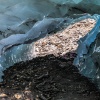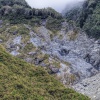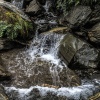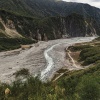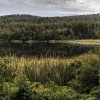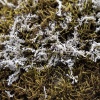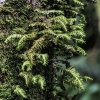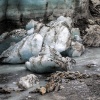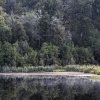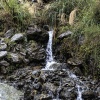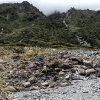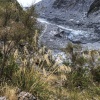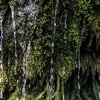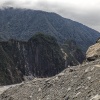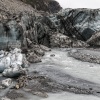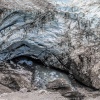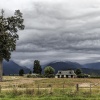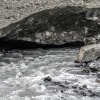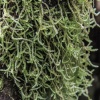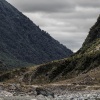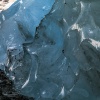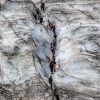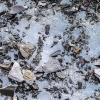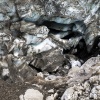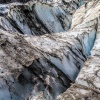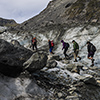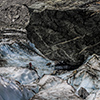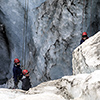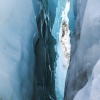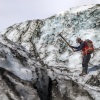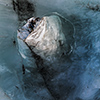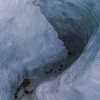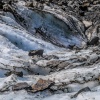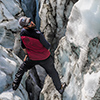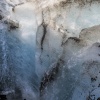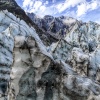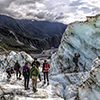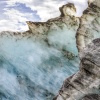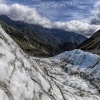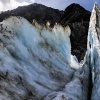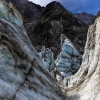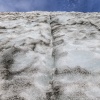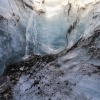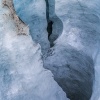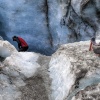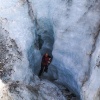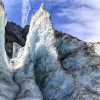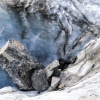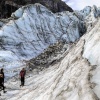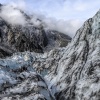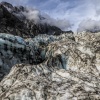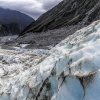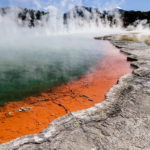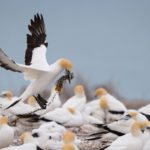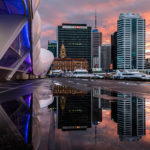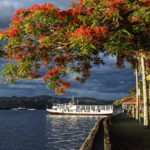Ice in the Rain Forest – Exploring the Fox Glacier
New Zealand’s West Coast region is unique. It is leader of the list of the rainiest regions on our planet and offers the possibility of getting in very close touch with the remarkable combination of a glacier gliding down amidst an environment of alpine mountains having rain forests on its slopes. To boot New Zealand has even two of those places, the Franz Josef Glacier as well as the Fox Glacier. Latter one originates from the western snow field surrounding Mount Tasman and I had an excursion leading from the glacier’s terminus up to the area where dramatic crevices and sharp edged ice shapes take over control; a place that already demanded the one or another human life.
Like many of New Zealand’s scenic hot spots there is only one company exclusively merchandising the miracles of nature, in that case glacier walks. No matter if glacier or other things, when you’re a professional and do it on your own, when you take all risks yourself, then you get in trouble with those people as they protect their main business entirely by threatening with fines, police etc.
Hence I swallowed the bitter pill and booked a guided day walk on the glacier. Daytrips demand a bit more stamina since you’re a day out but on the other hand you’ve got way much more time and can do the walk more relaxed than all shorter trips. In the morning for a short moment the sky was pretty clear and visibility excellent. From Fox Glacier (the municipality is meant) you could even see Mount Tasman as well as spot the col from where Fox Glacier (now the actual glacier is meant) originates.
Having arrived the Fox Glacier office (finally now the tourism company is meant) the guides held a briefing regarding schedule as well as equipment.
The appearance of a glacier is pretty much ambivalent. Sometimes it bristles up with all kinds of colours and sometimes it fades away into all kinds of grey by the debris carried along.
Being already well equipped myself – only the climbing irons, or better to say crampons, stayed in Berlin – things got kicked off immediately. People having no or not good enough equipment can still get appropriate shoes, clothing as well as crampons from their guide. Somehow I quickly noticed that Tyler loves what he’s doing, that is guiding, hence I joined his group. A group is usually a team of 10-12 people who will be around you on the glacier the whole day.
New Zealand’s West Coast is one of the rainiest places on Earth. “Within one hour up to 15 inches of precipitation can fall reaching the unbelievable mark of 11 metres per year in total”, says my guide Tyler, meaning the very Mount Cook area itself. Somehow the summer of 2013 was pretty dry though and the West Coast didn’t see rain for almost three months now. Of course that had an effect on the glacier as well as it was shorter and more slim than usual. Dryness also made the lateral moraines framing the trough valley being pretty much dusty. The glacier slides down the mountain slope pretty quickly as the full distance of roughly 3 kilometres gets covered in about 60 years only.
The signs along the way to the glacier, indicating when the end of the ice was where, are pretty thought-provoking as tragically they can show only one movement: backwards. Having reached the parking lot we’re getting prepared and split up into groups while behind us five coaches full of Chinese arrive. With big “Oh!” and “Ah!” shouts they embark wildly snap shooting around on their journey up to the glacier’s terminus.
Fortunately our tour starts differently on a path cut into the rocks framing the glacier valley. Already one the way to the glacier Tyler showed his value and gave us detailed information on biology as well as geology of the places we come across. For example he explains the unimposing pioneer plants, whose ability to produce nitrogen and breaking up ground is elementary for any other form of flora settling down. Stupidly those important plants are often delicacies for mountain goats.
A first highlight is the countless little waterfalls and springs along the path hewn into the mountain. Drinking from them or even only taking some refreshment for head and face is just wonderful. The way to the glacier decently wakes up the body. I give vent to myself as the onion peel concept of my clothing – long live Merino wool – does what it has to do: warming the body entirely. Up on the glacier this and a wind-proof jacket will become essential.
Shortly before entering the glacier itself we put on the crampons. Other guides are already on the ice cutting steps into it along the intended route or they are inspecting where and where not it is safe to walk before the visitors arrive. That is pretty much necessary since the glacier changes within hours. Deep fissures, in terms of glaciers called crevices, can emerge or disappear any time, so can thin ice structures or tunnels collapse.
Photographically it is very difficult to capture such a mass of ice as normally as a size comparison is only rarely manageable. Often there is only the possibility to photography the shapes, colours and contrasts of the ice.
The lower flat part of the Fox Glacier is carved by countless little gullies and drains. Everywhere somehow water is involved, sometimes more, sometimes less. To boot the glaciers has an omnipresent, inherent gurgling of water flowing inside. Crossing that ice mass without crampons would be horrible slide all over the place but with them it is big fun to slam the grip giving metal step by step hardly into the ice. Meanwhile the sky above us cleared out and allowed the sun to illuminate the ice surrounding us, making us having an afternoon full of optical ice shaped delights.
At noon as expected everyone got hungry and we stopped to have lunch. Food and also water are not included in the tour hence everyone had to bring one’s own stuff. While some people munch some cold noodles with tomato sauce, cereals or a sandwich I indulged myself into having smoked King Salmon and bread, surely a still remaining side effect of my Kamchatka travel ;-)
After lunch we continued and climbed further up to the glacier part having the crevices. In some of them we threw little stones. No echo, no sound came back… A couple of weeks ago a young mountaineer fell into one of the crevices around us. Fortunately there was a little terrace stopping her fall so mountain rescue could get her out. Despite a couple of broken bones she’s ok and recovering again.
The men rescuing that woman are Tyler’s bosses and “they are real badasses!” says our guide with big respect. They are men whose ancestors already trained the New Zealand based Mount Everest conqueror Sir Edmund Hillary. In fact they do all kinds of rescue all around the Fox Glacier municipality. Their icon is a large ice pick having a wooden handle. Every guide takes one onto the glacier. It’s a symbol whose tradition gets cultivated over there at Fox Glacier.
